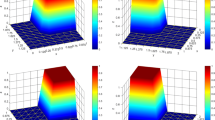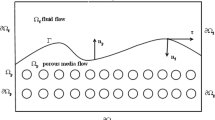Abstract
In this paper, based on two-grid discretizations and superposition principle, a new local and parallel finite element method is presented and studied for the coupled Stokes–Darcy model. Superposition principle is used to generate a series of local and independent subproblems to obtain a global continuous approximation. Optimal error estimates are derived. Numerical results are reported to support the theoretical findings.





Similar content being viewed by others
References
Cao, Y., Gunzburger, M., Hu, X., Hua, F., Wang, X., Zhao, W.: Finite element approximation for Stokes–Darcy flow with Beavers–Joseph interface conditions. SIAM. J. Numer. Anal. 47, 4239–4256 (2010)
Hou, Y., Qin, Y.: On the Solution of Coupled Stokes/Darcy Model with Beavers–Joseph Interface Condition. Comput. Math. Appl. 77, 50–65 (2019)
Layton, W., Schieweck, F., Yotov, I.: Coupling fluid flow with porous media flow. SIAM J. Numer. Anal. 40, 2195–2218 (2003)
Li, R., Gao, Y., Yan, W., Chen, Z.: A Crank–Nicolson discontinuous finite volume element method for a coupled non-stationary Stokes–Darcy problem. J. Comput. Appl. Math. 353, 86–112 (2019)
Li, Y., Hou, Y.: Error estimates of A second-order decoupled scheme for the evolutionary Stokes–Darcy system. Appl. Numer. Math. 154, 129–148 (2020)
Du, G., Zuo, L.: Local and parallel finite element methods for the coupled Stokes/Darcy model. Numer. Algorithms 87, 1593–1611 (2021)
Saffman, P.: On the boundary condition at the surface of a porous media. Stud. Appl. Math. 50, 93–101 (1971)
Xue, D., Hou, Y., Liu, W.: Analysis of the parareal method with spectral deferred correction method for the Stokes/Darcy equations. Appl. Math. Comput. 387, 124625 (2020)
Yu, J., Sun, Y., Shi, F., Zheng, H.: Nitsche’s type stabilized finite element method for the fully mixed Stokes–Darcy problem with Beavers-Joseph conditions. Appl. Math. Lett. 110, 106588 (2020)
Cai, M., Mu, M.: A multilevel decoupled method for a mixed Stokes/Darcy model. J. Comput. Appl. Math. 236, 2452–2465 (2012)
Du, G., Li, Q., Zhang, Y.: A two-grid method with backtracking for the mixed Navier–Stokes/Darcy model. Numer. Methods Part. Differ. Equ. 36, 1601–1610 (2020)
Mu, M., Xu, J.: A two-grid method of a mixed Stokes–Darcy model for coupling fluid flow with porous media flow. SIAM J. Numer. Anal. 45, 1801–1813 (2007)
Du, G., Zuo, L.: A two-grid method with backtracking for the mixed Stokes /Darcy model. J. Numer. Math. 29, 39–46 (2021)
Zuo, L., Hou, Y.: A two-grid decoupling method for the mixed Stokes–Darcy model. J. Comput. Appl. Math. 275, 139–147 (2015)
Zuo, L., Du, G.: A multi-grid technique for coupling fluid flow with porous media flow. Comput. Math. Appl. 75, 4012–4021 (2018)
Chen, W., Gunzburger, M., Hua, F., Wang, X.: A parallel robin-robin domain decomposition method for the Stokes–Darcy system. SIAM J. Numer. Anal. 49, 1064–1084 (2011)
Discacciati, M., Quarteroni, A., Valli, A.: Robin–Robin domain decomposition methods for the Stokes–Darcy coupling. SIAM J. Numer. Anal. 45, 1246–1268 (2007)
Discacciati, M., Quarteroni, A.: Convergence analysis of a subdomain iterative method for the finite element approximation of the coupling of Stokes and Darcy equations. Comput. Vis. Sci. 6, 93–103 (2004)
Feng, W., He, X., Wang, Z., Zhang, X.: Non-iterative domain decomposition methods for a non-stationary Stokes–Darcy model with Beavers–Joseph interface condition. Appl. Math. Comput. 219, 453–463 (2012)
Vassilev, D., Wang, C., Yotov, I.: Domain decomposition for coupled Stokes and Darcy flows. Comput. Methods Appl. Mech. Eng. 268, 264–283 (2014)
Du, G., Hou, Y., Zuo, L.: A modified local and parallel finite element method for the mixed Stokes–Darcy model. J. Math. Analy. Appl. 435, 1129–1145 (2016)
Du, G., Zuo, L.: Local and parallel finite element method for the mixed Navier–Stokes/Darcy model with Beavers–Joseph interface conditions. Acta Math. Sci. 37, 1331–1347 (2017)
Zuo, L., Du, G.: A parallel two-grid linearized method for the coupled Navier–Stokes–Darcy problem. Numer. Algorithms 77, 151–165 (2018)
Wang, X., Du, G., Zuo, L.: A novel local and parallel finite element method for the mixed Navier–Stokes–Darcy problem. Comput. Math. Appl. 90, 73–79 (2021)
Li, Y., Hou, Y.: A second-order partitioned method with different subdomain time steps for the evolutionary Stokes–Darcy system. Math. Methods Appl. Sci. 41, 2178–2208 (2018)
Shan, L., Zheng, H.: Partitioned time stepping method for fully evolutionary Stokes–Darcy flow with the Beavers–Joseph interface conditions. SIAM J. Numer. Anal. 51, 813–839 (2013)
Hou, Y.: Optimal error estimates of a decoupled scheme based on two-grid finite element for mixed Stokes–Darcy model. Appl. Math. Lett. 57, 90–96 (2016)
He, Y., Xu, J., Zhou, A., Li, J.: Local and parallel finite element algorithms for the Stokes problem. Numer. Math. 109, 415–434 (2008)
He, Y., Xu, J., Zhou, A.: Local and parallel finite element algorithms for the Navier–Stokes problem. J. Comput. Math. 24, 227–238 (2006)
Li, Q., Du, G.: Local and parallel finite element methods based on two-grid discretizations for the nonstationary Navier–Stokes equations. Numer. Algorithms (2021). https://doi.org/10.1007/s11075-021-01100-1
Shang, Y., He, Y.: Parallel iterative finite element algorithms based on full domain partition for the stationary Navier–Stokes equations. Appl. Numer. Math. 60, 719–737 (2010)
Shang, Y., He, Y., Kim, D., Zhou, X.: A new parallel finite element algorithm for the stationary Navier–Stokes equations. Finite Elem. Anal. Des. 47, 1262–1279 (2011)
Shang, Y., Wang, K.: Local and parallel finite element algorithms based on two-grid discretizations for the transient Stokes equations. Numer. Algorithms 54, 195–218 (2010)
Du, G., Zuo, L.: A two-grid parallel partition of unity finite element scheme. Numer. Algorithms. 80, 429–445 (2019)
Du, G., Zuo, L.: A parallel partition of unity scheme based on two-grid discretizations for the Navier–Stokes problem. J. Sci. Comput. 75, 1445–1462 (2018)
Du, G., Zuo, L.: Local and parallel finite element post-processing scheme for the Stokes problem. Comput. Math. Appl. 73, 129–140 (2017)
Du, G., Zuo, L.: A parallel iterative finite element method for the linear elliptic equations. J. Sci. Comput. 85, 35 (2020)
Larson, M., Målqvist, A.: Adaptive variational multi-scale methods based on a posteriori error estimation: energy norm estimates for elliptic problems. Comput. Methods Appl. Mech. Eng. 196, 2313–2324 (2007)
Song, L., Hou, Y., Zheng, H.: Adaptive local postprocessing finite element method for the Navier–Stokes equations. J. Sci. Comput. 55, 255–267 (2013)
Zheng, H., Yu, J., Shi, F.: Local and parallel finite element method based on the partition of unity for incompressible flow. J. Sci. Comput. 65, 512–532 (2015)
Zheng, H., Shi, F., Hou, Y., et al.: New local and parallel finite element algorithm based on the partition of unity. J. Math. Anal. Appl. 435, 1–19 (2016)
Zheng, H., Song, L., Hou, Y., et al.: The partition of unity parallel finite element algorithm. Adv. Comput. Math. 41, 937–951 (2015)
Yu, J., Shi, F., Zheng, H.: Local and parallel finite element algorithms based on the partition of unity for the Stokes Problem. SIAM, J. Sci. Comput. 36, C547–C567 (2014)
Evans, L.: Partial Differential Equations. American Mathematical Society (1997)
Beneš, M., Kučera, P.: Solutions to the Navier–Stokes equations with mixed boundary conditions in two dimensional bounded domains. Math. Nachr. 289, 194–212 (2016)
Grisvard, P.: Elliptic problems in nonsmooth domains. Society for Industrial and Applied Mathematics (2011)
Banasiak, J., Roach, G.F.: On mixed boundary value problems of Dirichlet oblique-derivative type in plane domains with piecewise differentiable boundary. J. Differ. Equ. 79, 111–131 (1989)
Hecht, F.: New development in FreeFem\(++\). J. Numer. Math. 20, 251–265 (2012)
Author information
Authors and Affiliations
Corresponding author
Additional information
Publisher's Note
Springer Nature remains neutral with regard to jurisdictional claims in published maps and institutional affiliations.
This work is subsidized by NSFC(Grant Nos. 12001234, 11801170, 12172202, 11701343) and Natural Science Foundation of Hunan Province, China (No. 2019JJ50365)
Rights and permissions
About this article
Cite this article
Du, G., Zuo, L. & Zhang, Y. A New Local and Parallel Finite Element Method for the Coupled Stokes–Darcy Model. J Sci Comput 90, 43 (2022). https://doi.org/10.1007/s10915-021-01723-5
Received:
Revised:
Accepted:
Published:
DOI: https://doi.org/10.1007/s10915-021-01723-5




